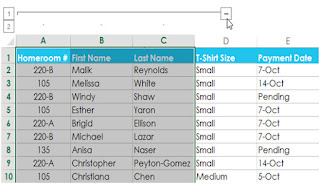Groups and Sub-totals in MS Excel 2013
Excel
2013 - Groups and Subtotals
MS Excel
can organize large amount of data of worksheets in groups,
allowing you to show and hide different
sections of your worksheet easily. And aslo to summarize the different groups using Subtotal command
and create an outline in a worksheet
To group rows or columns:
1.
Select
the rows or columns you want to group. Here we'll select columns A, B,
and C.
2. Click
the Data tab on the Ribbon, then
click on the Group command.
3.
The
selected rows or columns will be grouped.
To ungroup
the grouped data , select the grouped rows or columns, then click on Ungroup command.
To hide and show groups:
1. To
hide a group, click the Hide
Detail/- button.
2.
The group will
be hidden. To show a hidden group, click the Show Detail /+ button.
Creating subtotals
The Subtotal command
is used to automatically create groups and
use common functions like SUM, COUNT, and AVERAGE to help summarize the data. For example, the Subtotal command
could help to calculate the cost of office supplies by type from a large
inventory order. It will create a hierarchy of groups, known as an outline,
to help organize your worksheet.
Data must be sorted before
using the Subtotal command.
To create a subtotal:
Let us use
the Subtotal command with a T-shirt order form to check how many T-shirts were ordered in each size
(Small, Medium, Large, and X-Large). An outline for
the worksheet with a group for each T-shirt size and then count the
total number of shirts in each group will be created.
1. First of all , sort worksheet
data for which subtotal is required. Suppose we want to create a subtotal for
each T-shirt size, so our worksheet has been sorted by T-shirt size from
smallest to largest.
2.
Select
the Data tab, and then click on the Subtotal command.
3.
Subtotal dialog
box will appear. Click the drop-down arrow for the At each change in: field to select the column you
want to subtotal. Select T-Shirt Size.
4.
Click the
drop-down arrow for the Use function: field
to select the function you want to use. select COUNT to
count the number of shirts as per ordered
in each size.
5.
In
the Add
subtotal to: field,
select the column where you want the calculated subtotal to
appear. select T-Shirt
Size then click on OK
6. The worksheet will be outlined into groups, and the subtotal will
be listed below each group.
To view groups by level:
When you
create subtotals, your worksheet it is divided into different levels.
You can switch between these levels to quickly control how much information is
displayed in the worksheet by clicking the Level buttons  to
the left of the worksheet. While this example contains only three levels, Excel
can show up to eight levels.
to
the left of the worksheet. While this example contains only three levels, Excel
can show up to eight levels.
1.
Click
the lowest level to display the minimum detail. if we select level
1, it will show only the grand count, or total
number of T-shirts ordered.
2.
Click the next level to
expand the detail. In the level 2,
it only contains each subtotal row and hides
rest of the data from the worksheet.
3.
Click on the highest level to view and expand all the data of our worksheet .
Click on the highest level to view and expand all the data of our worksheet .
You can also use the Show and Hide Detail buttons
to show and hide the groups within the outline.
To remove subtotals:
When you don't
need to use subtotal then just remove it from
the worksheet.
1.
Select
the Data tab and then click on Subtotal command.
2. in the Subtotal dialog
box Click on Remove All.
3.
This will ungroup all worksheet data , and also the subtotals will be removed.
To remove all the groups without deleting subtotals, click the Ungroup command's
drop-down arrow, then choose Clear Outline.





Comments
Post a Comment